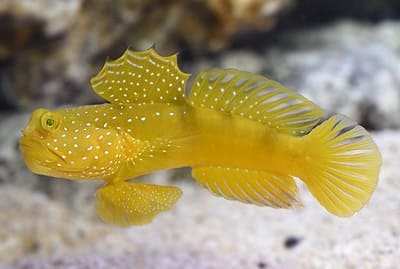Home › Sea Creatures › Marine Animals › Vertebrates › Gobies
Gobies Fish Facts and Information
[Phylum: Chordata] [Class: Actinopterygii] [Order: Perciformes] [Family: Gobiidae]
There aren't many families of bony fish that are more varied than gobies. In fact, there are well over two thousand different species in the order Gobiiformes.
This section contains fun facts and interesting information about the goby fish, including where to find them, what they eat, and how they reproduce.
Goby Fish Species Habitat and Distribution
Most gobies inhabit the various marine environments found around the world.
But, others exist quite well in brackish water, and some cope very well in fresh water (including home aquariums).
You will find most of these bottom-dwelling carnivores inhabiting:
- Estuaries and mangrove swamps
- Shallow coastal areas
- Tropical reef ecosystems
Unlike most vertebrate animal species, gobies are small. In fact, their species includes a tiny specimen that is less than one (1) centimetre in length, called the dwarf pygmy goby.
By comparison, the giant goby is the longest. It can grow up to twenty seven (27) centimetres (11 inches). Even so, most of the elongated adult species will not grow more than ten (10) centimetres long.
Goby Fish and Shrimp
Many exhibit a co-existent 'symbiotic relationship' with a burrowing shrimp, such as the yellow prawn-goby, also called the yellow watchman goby.
A goby fish guards the entrance of a small burrow in the mud or sand and provides food for the shrimp. In return, the blind shrimp shifts sand and loose sediment from the hole and provides a safe habitat for the goby to spawn.
Moving on...
Goby fish have unusual pectoral fins. The pectorals are fused together to form a disc-shaped sucker foot. They use it for clinging to rocks or for sticking to corals.
Fun Fact: Gobies fishes kept in glass aquariums as pets have been seen to use this same morphed appendage to stick themselves to the tank walls.
Different Goby Species
In the past, scientists and zoologists have come up with some weird fish names for new species. But, some of the best-known names for common gobies include:
 Bumblebee goby (Brachygobius doriae)
Bumblebee goby (Brachygobius doriae)- Dragon goby (Gobioides broussonnetii)
- Dwarf pygmy goby (Pandaka pygmaea)
- Flaming prawn goby
- Gobius cobitis (giant goby)
- Masked goby (Coryphopterus personatus)
- Red fire goby (Nemateleotris magnifica)
- Yellow prawn-goby (Cryptocentrus cinctus)
What Do Goby Fish Eat?
Their favourite food is algae, planktonic organisms, and other types of small invertebrates. Some of the largest goby species will feed on other small fishes. Whereas, the smallest of the genera will stick to planktonic algae for their food source.
Gobies Behaviour and Reproduction
Male and females typically share the burrow which provides them with a sheltered place to spawn. The genders dig with their mouths and keep the burrow clear of debris by fanning away sedimentary sand.
The size of the burrows is relative to the size of the goby. But the amount of burrowing can reach huge proportions - up to sixty (60) centimetres in diameter.
Gobies will place small fragments of shells, rubble, and corals to block the entrance of their hole, especially during spawning season.
Goby females often lay up to 5,000 eggs during the reproductive period. The eggs stick to vegetation such as coral and substrate. The male supervises the eggs for a few days until they hatch as new colourless larvae.
Most of the young will only take a few months to reach adult maturity. In general, warm water dwellers can live for a period of up to ten (10) years.
Related Information and Help Guides
- Blenny Fish Facts and Information with Pictures
- Flashlight Fish Fun Facts and Information
- Marine Vertebrates with Examples and Pictures
- Wrasse Fish Species Interesting Information
Note: The short video [3:35 seconds] presented by Love Nature shows how the pistol shrimp and goby fish join forces to dig a safe burrow to live in and evade predators.